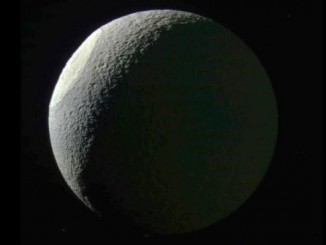
NASA/ESA Cassini mission

News

Picture This

News

News

Picture This

Picture This

Picture This

Picture This
Saturn’s past and present moons
Saturn’s beautiful rings form a striking feature, cutting across this image of two of the planet’s most intriguing moons: Titan (diameter, 3,200 miles) and Enceladus (313 miles). The rings have been a source of mystery since their discovery in 1610 by Galileo Galilei, but there is not full agreement on how they formed.

Picture This
Bright impact basin on Saturn’s icy moon Tethys
In this NASA/ESA Cassini mission image of Saturn’s 660-mile-wide moon Tethys, the giant impact basin Odysseus stands out brightly from the rest of the illuminated icy crescent. Some 280 miles across, Odysseus is one of the largest impact craters on Saturn’s icy moons, and may have significantly altered the geologic history of Tethys.

Picture This
